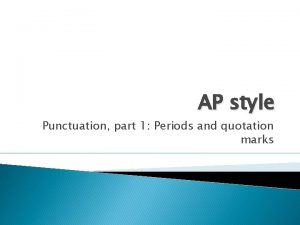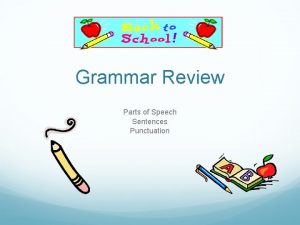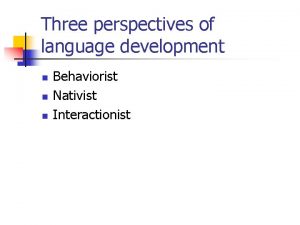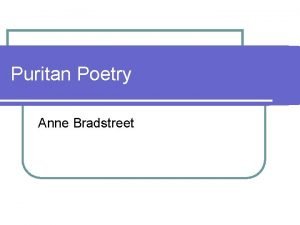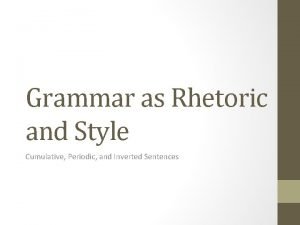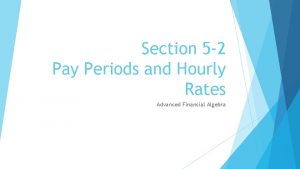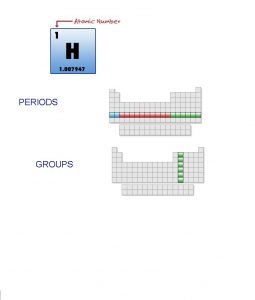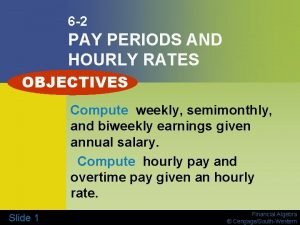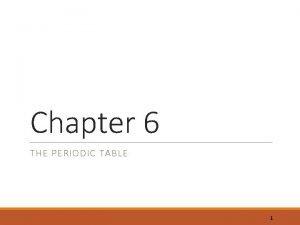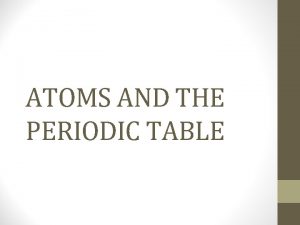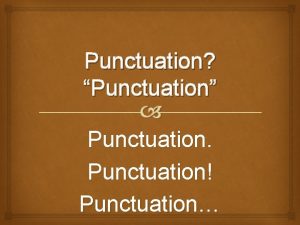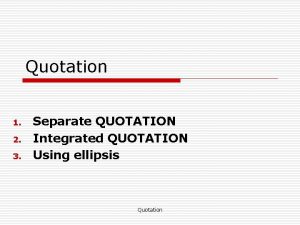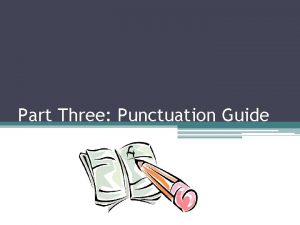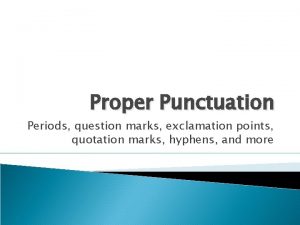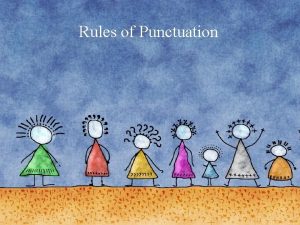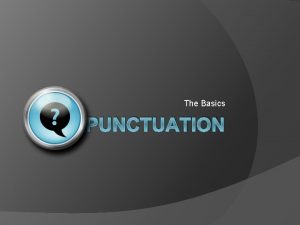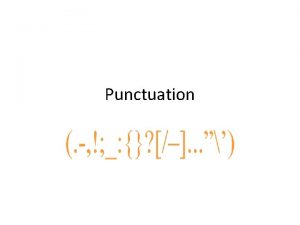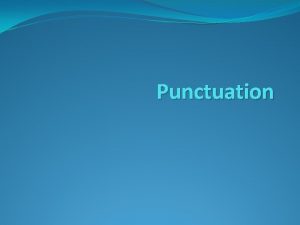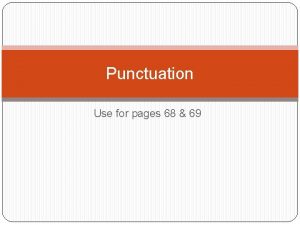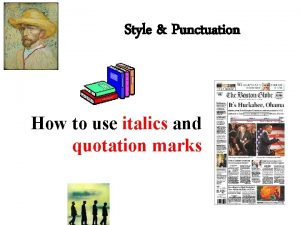AP style Punctuation part 1 Periods and quotation
















- Slides: 16

AP style Punctuation, part 1: Periods and quotation marks

Periods � As you know, a period is placed at the end of a declarative sentence. � Also, at the end of a mildly imperative sentence: Shut the door. � At the end of some rhetorical questions, when it is more of a suggestion than a question: Why don’t we go.

Initials, abbreviations � In general, refer to the abbreviations and acronyms entry we discussed before. � Initials: In a full name, initials are to contain periods. T. S. Eliot, John F. Kennedy. � When it is an abbreviation using only initials, no periods are used: JFK, LBJ

Indirect questions, spacing � Use a period instead of a question mark at the end of an indirect question: He asked what the score was. � When placing a period at the end of a sentence, use a single space before starting the next sentence.

Periods and quotation marks � Periods always go inside quotation marks. For example: “He is one of our finest soldiers. ” � Commas also always go within quotation marks. For example: “Back then, we never knew what we were missing, ” Jones said.

A quick review � As we have discussed, when we use a speaker’s exact words in our stories, it is a direct quote and those words are placed between quotation marks.

More than one sentence � For direct quotes that are more than one sentence, it’s best to attribute at the end of the first sentence. � For example: “This budget is the best we can do under the circumstances, ” Smith said. “We’re working hard to make sure that citizens won’t feel much impact from the cutbacks. ”

More than one paragraph � When directly quoting someone for more than one consecutive paragraph, no quote mark is placed at the end of the first paragraph. � For example: “I guarantee our players will work hard every day this season, ” Leyland said. “I won’t allow anything less than 110 percent. “Anyone who chooses to dog it out there won’t be on this team for long. ”

Irony, unfamiliar terms � Put quote marks around words used in an ironical sense: The “debate” turned into a free -for-all. � An unfamiliar word being introduced to readers may be placed between quote marks: Broadcast frequencies are measured in “kilohertz. ” � In subsequent references, you wouldn’t use quote marks around kilohertz. � Only use these conventions rarely.

Partial quotes � When using a small piece of a quote, place quote marks around just the exact words the speaker uses: She said she was horrified at their “slovenly manners. ” � It’s often better to use the full quote.

Unnecessary fragments � Do not use quotation marks to report a few ordinary words or an ordinary partial quote. � Example of what not to do: The senator said he would “go home to Michigan” if he lost the election. � Instead: The senator said he would go home to Michigan if he lost the election. � Why? Losing the election pretty much means a senator goes home, regardless.

Quotes within quotes � Alternate between double quotation marks (“”) and single quotation marks (‘’) � Ex. She said, “I quote from this letter, ‘I agree with Kipling that “the female of the species is more deadly than the male, ” but the phenomenon is not an unchangeable law of nature, ’ a remark he did not explain. ”

Three marks in a row … � Use three quote marks in a row if two quoted elements end at the same time. � For example: She said, “He told me, ‘I love you. ’” � Note where the period is placed in the example.

Other punctuation � Periods and commas always go within quotation marks. � Dashes, semicolons, question marks and exclamation points go within quotation marks when they apply to the quoted material. They go outside when they apply to the whole sentence.

Don’t forget � The rules for using quotation marks with books, magazines, movies, recorded music, plays, etc. are listed in the stylebook under composition titles.

Questions?
 Mla quotation marks and punctuation
Mla quotation marks and punctuation Ap style quotes
Ap style quotes Business letter format modified block
Business letter format modified block Punctuation part of speech
Punctuation part of speech Part of a flower comprising stigma style and ovary
Part of a flower comprising stigma style and ovary Difference between formal and informal tone
Difference between formal and informal tone Formal writing vs informal writing examples
Formal writing vs informal writing examples Referential style vs. expressive style
Referential style vs. expressive style Puritan plain style poem examples
Puritan plain style poem examples Periodic vs cumulative sentence
Periodic vs cumulative sentence Topic 15 periods authors and genres
Topic 15 periods authors and genres 5-2 pay periods and hourly rates
5-2 pay periods and hourly rates Groups and periods
Groups and periods English literary periods
English literary periods 6-2 pay periods and hourly rates
6-2 pay periods and hourly rates Groups and periods
Groups and periods Nucleus in periodic table
Nucleus in periodic table

